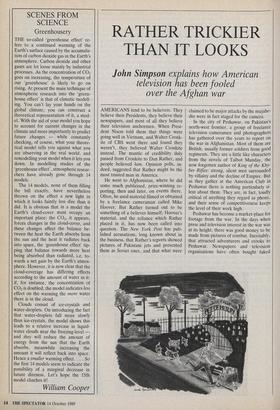SCENES FROM SCIENCE
Greenhousery
THE so-called 'greenhouse effect' re- fers to a continued warming of the Earth's surface caused by the accumula- tion of carbon dioxide gas in the Earth's atmosphere. Carbon dioxide and other gases are let loose mainly by industrial processes. As the concentration of CO2 goes on increasing, the temperature of our 'greenhouse' is likely to go on rising. At present the main technique of atmospheric research into the 'green- house effect' is that of climatic modell- ing. You can't lay your hands on the global climate; you can construct a theoretical representation of it, a mod- el. With the aid of your model you hope to account for current changes in the climate and more importantly to predict future changes — while constantly checking, of course, what your theore- tical model tells you against what you are observing in the real world, and remodelling your model when it lets you down. In modelling studies of the `greenhouse effect', atmospheric resear- chers have already gone through 14 models.
The 14 models, none of them filling the bill exactly, have nevertheless thrown on the effect a new light in which it looks faintly less dire than it did. It is obvious that in a model the Earth's cloud-cover must occupy an important place: the CO2, it appears, forces changes in the cloud-cover, and these changes affect the balance be- tween the heat the Earth absorbs from the sun and the heat it radiates back into space, the 'greenhouse effect' tip- ping that balance towards more heat being absorbed than radiated, i.e. to- wards a net gain by the Earth's atmos- phere. However, it is now clear that the cloud-coverage has differing effects according to the amount of water in it: if, for instance, the concentration of CO2 is doubled, the model indicates less effect on the warming the more water there is in the cloud.
Clouds consist of ice-crystals and water-droplets. On introducing the fact that water-droplets fall more slowly than ice-crystals, the model shows this leads to a relative increase in liquid- water clouds near the freezing-level and they will reduce the amount of energy from the sun that the Earth absorbs, meanwhile increasing the amount it will reflect back into space. Hence a smaller warming effect. . . . So the first 14 models seem to indicate the possibility of a marginal decrease in future direness. Let's hope the 15th model clinches it!
William Cooper


























































 Previous page
Previous page